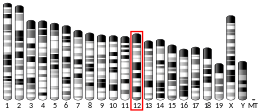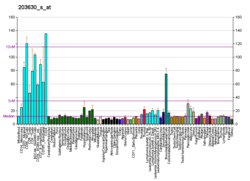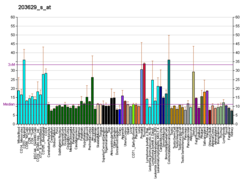Protein-coding gene in the species Homo sapiens
| COG5 |
|---|
|
| Identifiers |
|---|
| Aliases | COG5, CDG2I, GOLTC1, GTC90, component of oligomeric golgi complex 5 |
|---|
| External IDs | OMIM: 606821; MGI: 2145130; HomoloGene: 42221; GeneCards: COG5; OMA:COG5 - orthologs |
|---|
| Gene location (Human) |
|---|
 | | Chr. | Chromosome 7 (human)[1] |
|---|
| | Band | 7q22.3 | Start | 107,201,555 bp[1] |
|---|
| End | 107,564,514 bp[1] |
|---|
|
| Gene location (Mouse) |
|---|
 | | Chr. | Chromosome 12 (mouse)[2] |
|---|
| | Band | 12|12 A3 | Start | 31,704,868 bp[2] |
|---|
| End | 31,987,629 bp[2] |
|---|
|
| RNA expression pattern |
|---|
| Bgee | | Human | Mouse (ortholog) |
|---|
| Top expressed in | - corpus callosum
- Achilles tendon
- bone marrow cells
- sural nerve
- tonsil
- epithelium of colon
- skeletal muscle tissue
- endometrium
- smooth muscle tissue
- right auricle
|
| | Top expressed in | - genital tubercle
- tail of embryo
- spermatocyte
- ciliary body
- spermatid
- right ventricle
- dentate gyrus of hippocampal formation granule cell
- thymus
- neural layer of retina
- carotid body
|
| | More reference expression data |
|
|---|
| BioGPS | 
 | | More reference expression data |
|
|---|
|
| Gene ontology |
|---|
| Molecular function | - protein binding
- molecular function
| | Cellular component | - cytoplasm
- Golgi transport complex
- Golgi membrane
- cytosol
- Golgi apparatus
- membrane
- nucleoplasm
- trans-Golgi network membrane
| | Biological process | - protein transport
- endoplasmic reticulum to Golgi vesicle-mediated transport
- intra-Golgi vesicle-mediated transport
- transport
| | Sources:Amigo / QuickGO |
|
| Orthologs |
|---|
| Species | Human | Mouse |
|---|
| Entrez | | |
|---|
| Ensembl | |
|---|
ENSG00000164597
ENSG00000284369 |
| |
|---|
| UniProt | | |
|---|
| RefSeq (mRNA) | |
|---|
NM_001161520
NM_006348
NM_181733 |
| |
|---|
| RefSeq (protein) | NP_001154992
NP_006339
NP_859422
NP_001366440
NP_001366441
|
|---|
NP_001366442
NP_001366443
NP_001366444
NP_001366445 |
| |
|---|
| Location (UCSC) | Chr 7: 107.2 – 107.56 Mb | Chr 12: 31.7 – 31.99 Mb |
|---|
| PubMed search | [3] | [4] |
|---|
|
| Wikidata |
| View/Edit Human | View/Edit Mouse |
|
Conserved oligomeric Golgi complex subunit 5 is a protein that in humans is encoded by the COG5 gene.[5][6][7]
Multiprotein complexes are key determinants of Golgi apparatus structure and its capacity for intracellular transport and glycoprotein modification. Several complexes have been identified, including the Golgi transport complex (GTC), the LDLC complex, which is involved in glycosylation reactions, and the SEC34 complex, which is involved in vesicular transport. These 3 complexes are identical and have been termed the conserved oligomeric Golgi (COG) complex, which includes COG5 (Ungar et al., 2002).[supplied by OMIM][7]
Interactions
COG5 has been shown to interact with COG7[8] and COG4.[8]
References
- ^ a b c ENSG00000284369 GRCh38: Ensembl release 89: ENSG00000164597, ENSG00000284369 – Ensembl, May 2017
- ^ a b c GRCm38: Ensembl release 89: ENSMUSG00000035933 – Ensembl, May 2017
- ^ "Human PubMed Reference:". National Center for Biotechnology Information, U.S. National Library of Medicine.
- ^ "Mouse PubMed Reference:". National Center for Biotechnology Information, U.S. National Library of Medicine.
- ^ Walter DM, Paul KS, Waters MG (Dec 1998). "Purification and characterization of a novel 13 S hetero-oligomeric protein complex that stimulates in vitro Golgi transport". J Biol Chem. 273 (45): 29565–76. doi:10.1074/jbc.273.45.29565. PMID 9792665.
- ^ Ungar D, Oka T, Brittle EE, Vasile E, Lupashin VV, Chatterton JE, Heuser JE, Krieger M, Waters MG (Apr 2002). "Characterization of a mammalian Golgi-localized protein complex, COG, that is required for normal Golgi morphology and function". J Cell Biol. 157 (3): 405–15. doi:10.1083/jcb.200202016. PMC 2173297. PMID 11980916.
- ^ a b "Entrez Gene: COG5 component of oligomeric golgi complex 5".
- ^ a b Loh, Eva; Hong Wanjin (Jun 2004). "The binary interacting network of the conserved oligomeric Golgi tethering complex". J. Biol. Chem. 279 (23). United States: 24640–8. doi:10.1074/jbc.M400662200. ISSN 0021-9258. PMID 15047703.
Further reading
- Chen X, Bykhovskaya Y, Tidow N, et al. (2000). "The familial mediterranean fever protein interacts and colocalizes with a putative Golgi transporter". Proc. Soc. Exp. Biol. Med. 224 (1): 32–40. doi:10.1046/j.1525-1373.2000.22362.x. PMID 10782044.
- Loh E, Hong W (2002). "Sec34 is implicated in traffic from the endoplasmic reticulum to the Golgi and exists in a complex with GTC-90 and ldlBp". J. Biol. Chem. 277 (24): 21955–61. doi:10.1074/jbc.M202326200. PMID 11929878.
- Strausberg RL, Feingold EA, Grouse LH, et al. (2003). "Generation and initial analysis of more than 15,000 full-length human and mouse cDNA sequences". Proc. Natl. Acad. Sci. U.S.A. 99 (26): 16899–903. Bibcode:2002PNAS...9916899M. doi:10.1073/pnas.242603899. PMC 139241. PMID 12477932.
- Hillier LW, Fulton RS, Fulton LA, et al. (2003). "The DNA sequence of human chromosome 7". Nature. 424 (6945): 157–64. Bibcode:2003Natur.424..157H. doi:10.1038/nature01782. PMID 12853948.
- Ota T, Suzuki Y, Nishikawa T, et al. (2004). "Complete sequencing and characterization of 21,243 full-length human cDNAs". Nat. Genet. 36 (1): 40–5. doi:10.1038/ng1285. PMID 14702039.
- Loh E, Hong W (2004). "The binary interacting network of the conserved oligomeric Golgi tethering complex". J. Biol. Chem. 279 (23): 24640–8. doi:10.1074/jbc.M400662200. PMID 15047703.
- Oka T, Vasile E, Penman M, et al. (2005). "Genetic analysis of the subunit organization and function of the conserved oligomeric golgi (COG) complex: studies of COG5- and COG7-deficient mammalian cells". J. Biol. Chem. 280 (38): 32736–45. doi:10.1074/jbc.M505558200. PMID 16051600.
- Kimura K, Wakamatsu A, Suzuki Y, et al. (2006). "Diversification of transcriptional modulation: Large-scale identification and characterization of putative alternative promoters of human genes". Genome Res. 16 (1): 55–65. doi:10.1101/gr.4039406. PMC 1356129. PMID 16344560.
External links
- GeneReviews/NCBI/NIH/UW entry on Congenital Disorders of Glycosylation Overview
- Human COG5 genome location and COG5 gene details page in the UCSC Genome Browser.


















